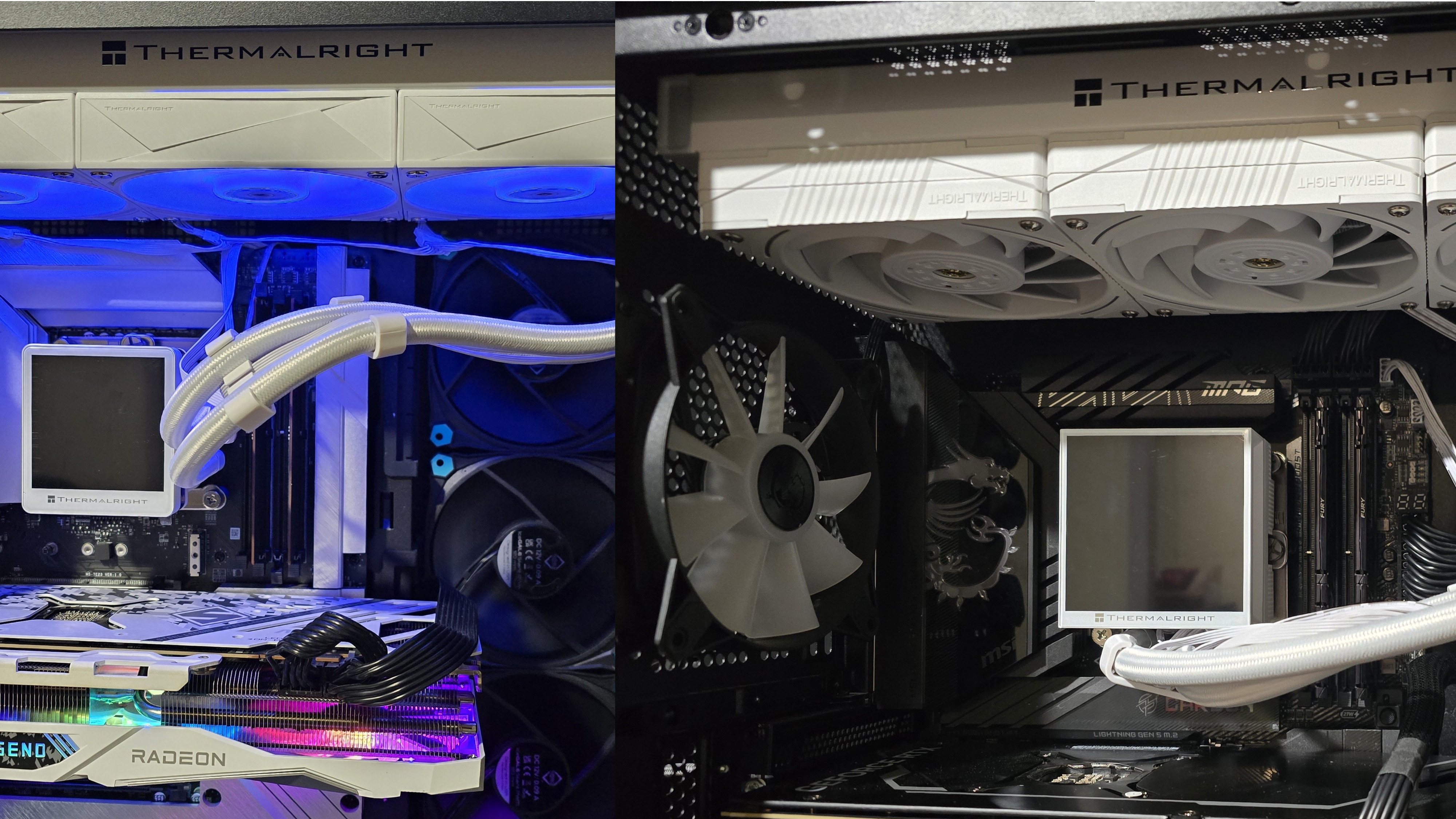The Hyper Vision 360 is the second product from Thermalright with packaging that I would describe as “fancy.” As you open the top, the white section with “low temperature, high performance” pops up – just like the previously reviewed Grand Vision 360. The product is secured with plastic wrappings and molded cardboard.
Included with the box are the following:
Three 120mm fans 360mm radiator and CPU block Thermal paste LCD screen Mounting accessories for modern AMD & Intel platforms Features of Thermalright’s Hyper Vision 360 ▶ Thermalright TF7 Thermal Paste
Included with the AIO is a small tube of Thermalright’s TF7 thermal paste. This is one of the better pastes on the market, as you can see in our best thermal paste
(Image credit: Tom’s Hardware) ▶ 480×480 3.95-inch display
One thing that immediately sets the Hyper Vision 360 apart from its competitors, at least in this price range, is the inclusion of a 3.95-inch LCD screen. While this screen is larger than the one included with the Grand Vision 360, it is the same resolution — so the quality of the image is effectively lower due to the decreased PPI of the screen being used.
(Image credit: Tom’s Hardware) ▶ Consumer unfriendly: Accessible refill port – but using it breaks the warranty
I go out of my way to recognize when companies don’t include a consumer-unfriendly “warranty void if removed” stickers on top of the refill port – an action which is technically illegal under the Magnuson-Moss Warranty Act
Thermalright includes an accessible refill port hidden behind a sticker with its logo on it, and while they don’t include a scary sticker on top of the refill port, their warranty policy is no different than those that do. If you attempt to service your AIO by refilling it, Thermalright will deny you warranty service.
What a shame!This is a consumer unfriendly move, especially when you consider that competitors such as BeQuiet not only allow this – but encourage it by including additional coolant with AIOs like the Light Loop 360
(Image credit: Tom’s Hardware) ▶ Standard 27mm radiator
The radiator included has a standard 27mm thickness, which means it should fit in the vast majority of ATX PC cases, without space constraints.
▶ Discernable pump whine
During testing, I noticed that the AIO’s pump emitted a subtle whine. While not overly loud, it almost interfered with noise-normalized assessments which I run at 38.9 dBA – and many users will prefer their pumps to run at 36.4 dBA or quieter.
This type of issue with a liquid pump is more of a hassle to deal with compared to potential problems with an air cooler – it’s easier to replace a fan than it is to go through the process of RMAing an AIO for having a noisy pump and being potentially told it is operating within expected performance.
This is a factor worth considering when investing in liquid cooling if you’re not fully confident in the ease of a company’s warranty process.
▶ Mixed Bag: Software with tons of customization options, but stability may vary
You don’t need to install Thermalright’s software to operate the AIO normally, but you’ll need to download it if you wish to customize the display – and if you paid extra for a screen, why wouldn’t you want to customize it? Thermalright doesn’t make it obvious where to download the software, but this link will take you to the company’s TRCC software
(Image credit: Tom’s Hardware) At first glance, you’ll see the screen above and might think that Thermalright’s software is rather basic. The software is deceptively simple looking, but exploring the options further reveals a wide variety of preset customization options – more than I’ve seen from any other AIO software I’ve used before.
That said, your mileage may vary when dealing with this software. While my own personal experience with Thermalright’s software has been flawless, I’ve received reports from users having problems with the software on social media and the Tom’s Hardware Discord server. Some of these users I’ve been able to help resolve their problems, but others I’ve been unsuccessful in helping to troubleshoot.
Image 1 of 3
(Image credit: Tom’s Hardware)
(Image credit: Tom’s Hardware)
(Image credit: Tom’s Hardware)
▶ Cable management features
Thermalright’s Hyper Vision AIO features pre-installed fans with a quick-connect system; the cables are routed through the tubing of the AIO with clips. This was a good effort. But it ends up a tad bit messier than needed. This is a minor complaint overall though. The bigger problem with this SKU is its inferior performance compared to similarly named Thermalright products.
(Image credit: Tom’s Hardware) ▶ 120mm TL-K12W fans
There’s more to a cooler than just the heatsink or radiator. The bundled fans have a significant impact on cooling and noise levels, as well as how the cooler looks in your case.
(Image credit: Tom’s Hardware) These fans are 25mm thick and have a quick connect system designed to simplify installation and (in theory) reduce cable clutter, and have subtle ARGB accents.
Swipe to scroll horizontally
Dimensions
120 x 120 x 25mm
Fan Speed
2150 RPM ± 10%
Air Flow
Up to 69 CFM
Air Pressure
Up to 2.87 mmH2O
Bearing Type
S-FDB V2
MTTF
Unlisted
Lighting
ARGB accents
Swipe to scroll horizontally
CPU
Intel Core i7-14700K
GPU
ASRock Steel Legend Radeon 7900 GRE
Motherboard
MSI Z790 Project Zero
Case
MSI Pano 100L PZ Black
System Fans
Iceberg Thermal IceGale Silent
There are many factors other than the CPU cooler that can influence your cooling performance, including the case you use and the fans installed in it. A system’s motherboard can also influence this, especially if it suffers from bending
In order to prevent bending from impacting our cooling results, we’ve installed Thermalright’s LGA 1700 contact frame our review of the contact frame
I’ve also tested this cooler with Intel’s latest platform, Arrow Lake and LGA 1851.
Swipe to scroll horizontally
CPU
Intel Core Ultra 9 285K
GPU
MSI Ventus 3X RTX 4070Ti Super
Motherboard
MSI Z890 Carbon Wifi
Case
MSI MPG Gungnir 300R
System fans
Pre-installed case fans
LGA 1700 and 1851 Installation The installation of this AIO is simple. The following steps assume that you will mount the radiator to your case first, which is generally a good idea unless you are building in a very cramped case.
1. You’ll first need to place the backplate against the rear of the motherboard.
(Image credit: Tom’s Hardware) 2. Next, you’ll secure the backplate by attaching standoffs. You’ll then place the mounting bars on top of the standoffs, and secure them with the included screws.
(Image credit: Tom’s Hardware) 3. Apply the included thermal paste to your CPU. If you have any questions on how to do this properly, please refer to our handy guide on how to apply thermal paste
4. Place the CPU block on top of the CPU, and secure it with a screwdriver. Attach the LCD screen after securing the CPU block.
(Image credit: Tom’s Hardware) 5. Connect the PWM and ARGB cables to your motherboard. If you wish to use the display, you’ll need to connect the USB cable to the CPU block on one end, and to a USB and SATA power header on the other.
6. Next you can power on your computer, as installation is complete.
(Image credit: Tom’s Hardware) 








